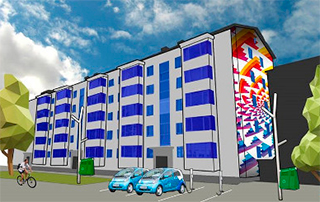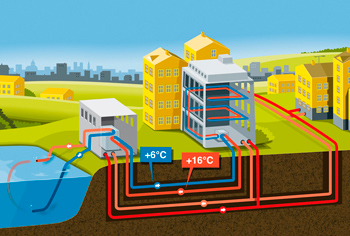Heat production technologies for district heating are only as efficient as the network they serve. Even if a heat plant is operating at 100% efficiency, heat loss due to the poor thermal insulation of buildings will create an “efficiency” ceiling that improvements at the heat production level cannot overcome. It would be as if a person were trying to heat their home in the winter with all the windows open. This analogy highlights one the biggest challenges for transitioning to ultra-low temperature district heating1 (ULTDH); How can a district heating (DH) operator improve the thermal efficiency for buildings they do not own?
AUTHOR: Richard Karl Henahan – Research Analyst at the Institute of Baltic Studies.
For the RELaTED project, the solution is technology. In test sites located in Spain, Denmark, Serbia, and Tartu, ULTDH is being tested with the help of building level technologies such as solar thermal panels, triple function sub-systems and district heating reversible heat pumps (RELaTED concept). The selling point for this solution is the potential long-term savings from lowering the supply temperature in the district heating network (DHN). For some building owners, the savings may be enough to entice them to commit to expensive upgrades to their home and heating system.
To maximize the benefits of ULTDH for the entire network, innovative technology alone will not be enough. DH customers must be supported and encouraged to adopt technological solutions at the building level. Fortunately, the SmartEnCity project, an EU funded project that is running in parallel to RELaTED in Tartu, Estonia, offers a glimpse into what a community-oriented solution to DH could look like.
The SmartEnCity project, an EU funded project that is running in parallel to RELaTED in Tartu, Estonia, offers a glimpse into what a community-oriented solution to DH could look like.
SmartEnCity
The SmartEnCity project is funded under the EU’s Horizon 2020 research and innovation programme and, under the coordination of TECNALIA, consists of 35 partners from six different countries. The main objective of the programme is to develop a highly adaptable and replicable approach for transforming European cities into sustainable, smart, and resource-efficient urban environments. [1]
In the SmartEnCity project, Tartu is implementing a range of solutions that will decrease CO2 emissions, decrease final energy consumption, and increase the share of renewable energy. The two most relevant smart solutions to the district heating system – and the RELaTED project – are the (1) Tartu retrofitting package, (2) and the district cooling system. [1]
Retrofitting package
The retrofitting package is an ambitious endeavour which turns soviet era khruschyovkas (apartment buildings built in the 1960’s) into smartovkas (apartment buildings after energy efficient upgrades). The retrofitting package includes several technological and infrastructure upgrades to the apartment buildings that will increase their energy efficiency and encourage behavioural changes in the way their residents consume energy. [2]
An overview for these upgrades is included in the following table:
Table 1 Retrofitting upgrades. [2]
| Technological upgrades | Building infrastructure upgrades |
| Installing a ventilation system with heat exchangers. | Insulating all outer walls of the buildings with pre-insulated panels. |
| Reconstructing the central heating system and installing thermostatic valves that allow to adjust room temperature in the range of 18-23°C. | Replacing all windows with triple-glazed windows and adding an insulation layer. |
| Adding low-temperature cooling systems to complement the district heating system. | Replacing all front doors to reduce heat loss. |
| Installing 400-500 kWp PV panels to provide additional energy for the buildings. | Insulating and reconstructing the roofs. |
| Setting up a smart home system to monitor energy consumption – including heat – and smoke and CO2 detectors. | Applying art solutions on the facades to increase the aesthetic appeal of the buildings. |
| Integrate the use of district hot water for domestic use in the Smartovkas (previously, residents used individual gas or electric boilers for the apartments). |
The retrofitting package will be implemented on 18 apartment buildings with a total of 32,217 m2 being renovated within the pilot area. Benefits from the retrofit equate to increased resource and energy efficiency, resulting in smaller energy bills; autonomy from fossil fuels and independence of energy supply; stable, long-term return on investment from energy savings; and increased value of the pilot buildings. To pay for the retrofitting project, the renovations were funded by H2020 (ca. 45%), a national support scheme for renovation activities (ca. 25%), and the rest was paid for by the dwelling owners (ca. 35%). [2]
The retrofitting package will be implemented on 17 apartment buildings with a total of 32,071 m2 being renovated within the pilot area.
 Not only are the renovations important for increasing the energy efficiency of the homes, but they are also directly linked with the feasibility of the ULTDH solution in the RELaTED project, i.e. without the upgrades, ULT levels (<60oC) are not possible within the DHN. Currently, the radiators of the apartment buildings were designed with a max temperature of 90oC, which by today’s standards is very high and less comfortable for the residents. This is mainly due to the poor thermal insulation of the walls, windows, and other structural elements for the Kruschyovkas, which necessitated high supply temperatures due to heat loss. But with the retrofitting package, the apartment buildings can lower the heat to ULT levels. As a result, the DH company and their customers benefit from less heat loss and higher energy savings due to a lower demand for heat.
Not only are the renovations important for increasing the energy efficiency of the homes, but they are also directly linked with the feasibility of the ULTDH solution in the RELaTED project, i.e. without the upgrades, ULT levels (<60oC) are not possible within the DHN. Currently, the radiators of the apartment buildings were designed with a max temperature of 90oC, which by today’s standards is very high and less comfortable for the residents. This is mainly due to the poor thermal insulation of the walls, windows, and other structural elements for the Kruschyovkas, which necessitated high supply temperatures due to heat loss. But with the retrofitting package, the apartment buildings can lower the heat to ULT levels. As a result, the DH company and their customers benefit from less heat loss and higher energy savings due to a lower demand for heat.
The district cooling system
 The district cooling system in Tartu delivers chilled water to non-residential buildings located near the smartovkas. The cooling plant is located next to the Emajõgi river, allowing the plant to use river-cooled chillers as part of the high-performance production solution. Water from the river is used for free cooling from October to April. Generally, cooling processes rely on electricity to operate (air-conditioning systems), but by using water from the river, the project will decrease the need of electricity by 70% annually compared to local cooling solutions, resulting in a reduction of CO2 by 70% or 6,000 tons per year. [3]
The district cooling system in Tartu delivers chilled water to non-residential buildings located near the smartovkas. The cooling plant is located next to the Emajõgi river, allowing the plant to use river-cooled chillers as part of the high-performance production solution. Water from the river is used for free cooling from October to April. Generally, cooling processes rely on electricity to operate (air-conditioning systems), but by using water from the river, the project will decrease the need of electricity by 70% annually compared to local cooling solutions, resulting in a reduction of CO2 by 70% or 6,000 tons per year. [3]
The installation of the district cooling system was designed to have a harmonious relationship with the district heating system, where residual heat created from cooling water can be captured and cycled through the DH system to provide heat to customers. Additionally, a portion of the power load needed for the cooling system will be provided by solar panels, which makes both the heating and cooling network less reliant on fossil fuels, cost effective, and environmentally friendly. [3]
Synergies with the RELaTED project can be found with the waste heat capture from the district cooling processes. As one of the main features of the RELaTED project, integrating waste heat into the district network leads to increased resource and energy efficiency for both the DH company and the DH customer. Further, waste heat sources are usually produced at lower temperatures, so if the supply and return temperature within a DHN are too high, it would not be feasible to integrate those heat sources into the DHN. Therefore, by lowering the temperature to ULT levels, the DHN can use more residual heat sources that would otherwise go unused.
Informing the community
District heating networks serve a diverse set of stakeholders with different needs. To encourage the adoption of new technologies and the retrofitting of residential homes, the cooperation and willingness of the community is necessary. In SmartEnCity, active citizen engagement was pursued to boost participation and interest for the smart solutions. Such activities included regular information meetings, technical consultations, study trips to construction sites, forum discussions, and other events. The purpose for these activities is to educate the community about the project, the proposed solutions and how the participants will benefit from the solutions. [4]
Support for community members does not stop once the main project activities have finished. After the retrofitting project is complete, the citizen engagement strategy will be replaced with a social innovation model that focuses on how to motivate the residents to use the installed smart devices in their home and save energy. [4]
Particularly for the retrofitting project, community outreach is crucial as a significant investment by the homeowners is needed.
Particularly for the retrofitting project, community outreach is crucial as a significant investment by the homeowners is needed. Without the support from building owners, such an extensive building renovation would not be possible.
Bringing the pieces together
The complimentary projects in Tartu can be viewed as a blueprint for how to transition to a cost effective and efficient ULTDH network. The parallel running projects – RELaTED and SmartEnCity – allow for interested stakeholders to observe how separate solutions can be combined to enhance the efficiency of the entire district heating network.
While unique in their methodologies, both projects contribute to developing a highly efficient district heating system which uses renewable energy sources, increases energy savings for DH customers and DH companies, reduces fossil fuel consumption, and enhances the quality of life for the citizens in Tartu.
References:
[1] SmartEnCity project. (2021). Retrieved from: https://SmartEnCity.eu/. Accessed on 2/3/2021.
[2] Tartu retrofitting package. (2021). Retrieved from: https://SmartEnCity.eu/about/solutions/tartu-retrofitting-package/. Accessed on 2/3/2021.
[3] District cooling system that uses residual heat. (2021). Retrieved from: https://SmartEnCity.eu/about/solutions/district-cooling-system-that-uses-residual-heat-tartu/. Accessed on: 2/3/2021.
[4] Social innovation experiences. (2021). Retrieved from: https://SmartEnCity.eu/about/solutions/social-innovation-experiments-tartu/. Accessed on: 2/3/2021.
1 Ultra-low temperature district heating is classified as having a supply and return temperature that is below 60oC.
